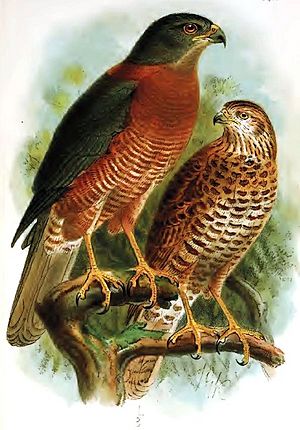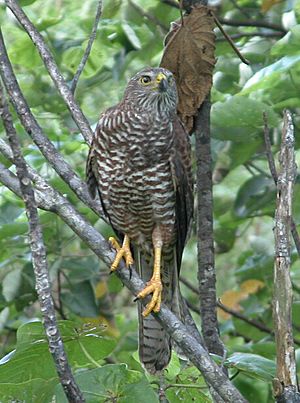Christmas goshawk facts for kids
Quick facts for kids Christmas goshawk |
|
|---|---|
 |
|
| Conservation status | |
| Scientific classification |
|
| Kingdom: | Animalia |
| Phylum: | Chordata |
| Class: | Aves |
| Order: | Accipitriformes |
| Family: | Accipitridae |
| Genus: | Accipiter |
| Species: | |
| Subspecies: |
A. f. natalis
|
| Trinomial name | |
| Accipiter fasciatus natalis (Lister, 1889)
|
|
| Synonyms | |
|
|
The Christmas goshawk (Accipiter fasciatus natalis), also known as the Christmas Island goshawk, is a type of bird of prey. It belongs to the Accipitridae family, which includes goshawks and sparrowhawks. This special bird is found only on Christmas Island, an Australian territory in the eastern Indian Ocean. It is a threatened animal, meaning its population is at risk.
Contents
About Its Name
Scientists who study animals, called biologists, first described the Christmas goshawk in 1889. They named it Accipiter natalis. For a long time, there was a discussion about whether it was its own unique species or a subspecies of another bird.
Today, most scientists consider it a subspecies of the brown goshawk. This means it's a special type of brown goshawk found only on Christmas Island. More studies are being done to learn even more about its family tree.
What It Looks Like
The Christmas goshawk is smaller than other brown goshawks. It also has wings that are more rounded. Its colors are similar to other goshawks, but its neck, head, and ear areas are dark grey. These parts do not have a brown color.
Female Christmas goshawks are noticeably larger than the males.
Where It Lives
This goshawk lives only on Christmas Island, which is about 135 square kilometers (52 square miles) in size. It mostly lives in the tropical rainforest that covers about 75% of the island. You can also find it in areas where new forests are growing or at the edges of open spaces.
How It Behaves
What It Eats
The Christmas goshawk eats many different kinds of animals. These include birds, small mammals, reptiles, and insects. It can catch its food either from the ground or while flying.
This bird is a skilled hunter. It might wait quietly on a tree branch for its prey. Or, it might chase other birds through the forest to catch them.
Its Future and Protection
The Christmas goshawk is listed as an endangered species. This means it is in danger of disappearing forever. Scientists do not have exact numbers for how many goshawks there are. However, they believe there are fewer than 100 adult birds left on the island. This might mean fewer than 50 breeding pairs.
The biggest danger to these goshawks comes from yellow crazy ants. These ants were accidentally brought to Christmas Island. The ants can directly harm young goshawks in their nests. They also cause big changes to the island's environment, which can indirectly hurt the goshawks.



